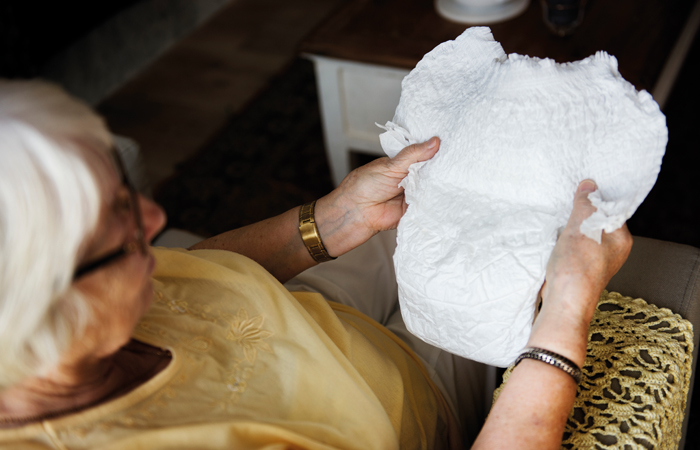Managing bladder weakness
In OTC
Follow this topic
Bookmark
Record learning outcomes
Many people with bladder weakness suffer in silence, but it is time to tackle the taboo. Find out how pharmacy can help
Sometimes a little sensitivity can go a long way. Pharmacy teams see it all and are often the first port of call for advice on many different ailments. But pharmacies themselves provide a space for people to come and safely chat about sensitive or potentially embarrassing issues, such as bladder weakness.

Bladder weakness affects one in three women and one in four men, meaning there are more than nine million people in the UK suffering from the condition. Many people don’t seek help as they are embarrassed or think that there are no treatments, yet there are plenty of options available within the pharmacy to help prevent and manage the condition. By understanding the causes and symptoms of bladder weakness, pharmacy teams can support customers with the right advice and prevent the condition from interfering with everyday life.
The specifics
A normal functioning bladder can hold up to a pint of urine and empties completely each time urine is passed. It does not leak urine and can send signals to the brain when it is full, with sufficient time to find a toilet. Bladder weakness is a condition where the bladder leaks involuntarily; this can be a few drops or even the entire contents of the bladder. There are various types of the condition, classified by cause.
- Stress
The most common form of bladder weakness is stress incontinence. Jane Simpson, continence specialist at The London Clinic, explains that “research tells us urinary stress incontinence affects between 25 and 45 per cent of women”, and she believes that this is an underestimation of the problem.
Stress incontinence is caused by weakness of the outer sphincter and pelvic floor. The physical stress caused to the pelvic floor muscles when a person coughs, sneezes, laughs, exercises or when lifting can cause a small amount of urine to leak. Pregnancy, childbirth and the menopause can be causes for women. Men can also be affected by stress incontinence, especially after the age of 40 when the prostate gland can get bigger, restricting the flow of urine.
- Urge
Urge incontinence is when urine leaks out when the person feels an intense urge to pass urine. It can be quite sudden, leading to the person not being able to get to the toilet in time. Passing urine more frequently, maybe every half an hour, is also a symptom of urge incontinence.
It can be caused by infections of the bladder, an overactive bladder or due to neurological conditions such as Parkinson’s disease. Sometimes incontinence can be described as mixed incontinence – a combination of both stress and urge incontinence.
- Overflow
Overflow incontinence is when the bladder does not fully empty and so a build-up of urine occurs, leading to leakage. Signs of overflow incontinence may also include difficulty in being able to start passing urine, or having a feeling that the bladder is still not empty. There are many reasons for the bladder not to empty fully. These include an obstruction such as enlarged prostate gland in men, severe constipation resulting in the bowel pressing on the bladder and medical conditions such as diabetes, stroke or multiple sclerosis.
- Nocturia
Nocturia incontinence mainly affects customers over the age of 60. It occurs when a person is woken up several times at night to pass urine, which can then result in them feeling constantly tired and so limiting what they can do during the day.
Urinary incontinence affects one in three women and one in four men
Available options
If a customer is concerned that they may have bladder weakness and have not had a diagnosis, pharmacy teams can advise them to consult with a GP so that any underlying health conditions can be addressed. “When problems with urinary incontinence arise, customers all too often assume that nothing can be done about it and the taboos around issues such as incontinence prevent customers from seeking professional help,” says Jane. But help is available. Customers can be advised about keeping a bladder diary for at least three days, which involves keeping a record of the following information:
- What type and how much fluid is drunk
- How often urine is passed
- The amount that is passed
- How many times incontinence was experienced and the severity of each episode
- How many times an urgent need to pass urine was experienced.
Some customers may need treatment with medication, most commonly anticholinergics, mirabegron, alpha blockers and topical oestrogen. “For menopausal women, hormone replacement therapy can protect from urinary symptoms, such as urinary frequency, urgency and infections, by helping to rebalance hormone levels,” explains Jane.
Pharmacy teams can also support customers with bladder weakness by recommending suitable products and advice to make them feel more confident to carry on with their everyday activities without worrying about urine leakages. There are a number of incontinence products that customers may find useful in managing their symptoms, including liners, pads, pants and bedding protectors, and pharmacy teams can help them choose the right product for them.
- Liners are designed to be discreet, whilst providing security against leakage. These are suitable for customers suffering from light urinary incontinence, for example small leaks from stress incontinence. These are more absorbent than ordinary sanitary towels and are designed to absorb sudden urine flow from small leakages, as well as neutralising odour
- Pads are similar to liners, but are more absorbent and so can be used for light to moderate urinary incontinence. Pads are available in different absorbency grades for both men and women. The pads designed for men are cup shaped to follow the male anatomy. Night-time pads are designed to provide better protection when lying down
- Pants offer high absorbency and are an alternative for customers who wish to use pads but want a more secure fit and feel. These can be reusable or disposable
- Bedding protectors are available as waterproof mattress covers or absorbent sheets, which can be washable or disposable.

Building strength
As well as advising on products to help manage symptoms of bladder weakness, pharmacy teams can offer customers additional information about how to improve their condition by strengthening the pelvic floor muscles.
Pelvic floor muscles span the bottom of the pelvis, supporting the bladder and bowel in men and the bladder, bowel and uterus in women. These muscles can be consciously controlled and strengthened through training. To find the pelvic floor muscles, men and women can stop urination mid-stream or tighten the muscles that stop them from passing wind, as both these manoeuvres use the pelvic floor muscles.
To exercise the pelvic floor muscles, customers should practise squeezing them 10-15 times in a row. This should be done without holding the breath or using other muscles in the stomach or buttocks. The number of squeezes and the length of time they are held for should be gradually increased. It can take three to six months to see any beneficial effects on stress incontinence. “Most customers are familiar with the concept of pelvic floor exercise, but too often don’t do them properly or practise them regularly enough, if at all,” explains Jane. She recommends using various apps that are available to remind customers to do their exercises.
Other methods to train the pelvic floor muscles can be discussed with a GP and include:
- Electrical stimulation, which is useful if a customer is unable to contract their pelvic floor muscles. An electric current is passed through a probe that is inserted into the vagina or anus, helping to strengthen the muscles
- Biofeedback also involves having a small probe inserted in the vagina or anus. It is used to sense when the muscles are being squeezed and allows this information to be seen on a computer screen and feedback given to the individual
- Vaginal cones are small weighted cones that are inserted into the vagina. The pelvic floor works to keep these in place. The weight of the cone can be increased gradually as the muscles get stronger.
Pelvic floor muscles are the layer of muscles that span the bottom of the pelvis
Healthy living advice
Offering customers with bladder weakness good healthy living advice will also make a big difference to the severity of their symptoms. Pharmacy teams can suggest the following:
- Keep fluid intake up – around six to eight glasses a day
- Eat a well-balanced, healthy diet with plenty of fibre
- Reduce or avoid fizzy drinks, caffeine and alcohol
- Avoid spicy and/or acidic foods
- Maintain a healthy weight as excess body fat can put pressure on the bladder
- Keep active and exercise regularly
- Avoid going to the toilet ‘just in case’ as this can encourage the bladder to be more irritable or sensitive. Practise waiting until the bladder feels full
- Practise pelvic floor exercises correctly and regularly.
Consultation skills
Recognising that customers may feel embarrassed, shy or uneasy about discussing bladder weakness in a pharmacy is important. By being mindful of this and offering understanding, reassuring advice and support to customers who need help with bladder control, pharmacy teams can make a real difference to their quality of life.
Customers seeking advice on bladder weakness should be able to do so in a private, quiet space in the pharmacy, away from other customers. Having samples of pads and pants available in the consultation room is also a good idea as it allows the customer to physically feel and see the product and will also allow them to self-assess if it will be absorbent enough for them.
Pharmacy team members should talk about bladder weakness in just the same way as another medical condition would be discussed. Try using the WWHAM questions as part of the conversation, as this will help the customer to feel more at ease and provide all the information needed for recommending products and providing useful advice.
Being able to talk confidently about the items available and not showing discomfort about dealing with these products or the topic will help the customer feel more relaxed when asking for advice. It may be helpful to practise role-play exercises with colleagues to help improve these skills.
